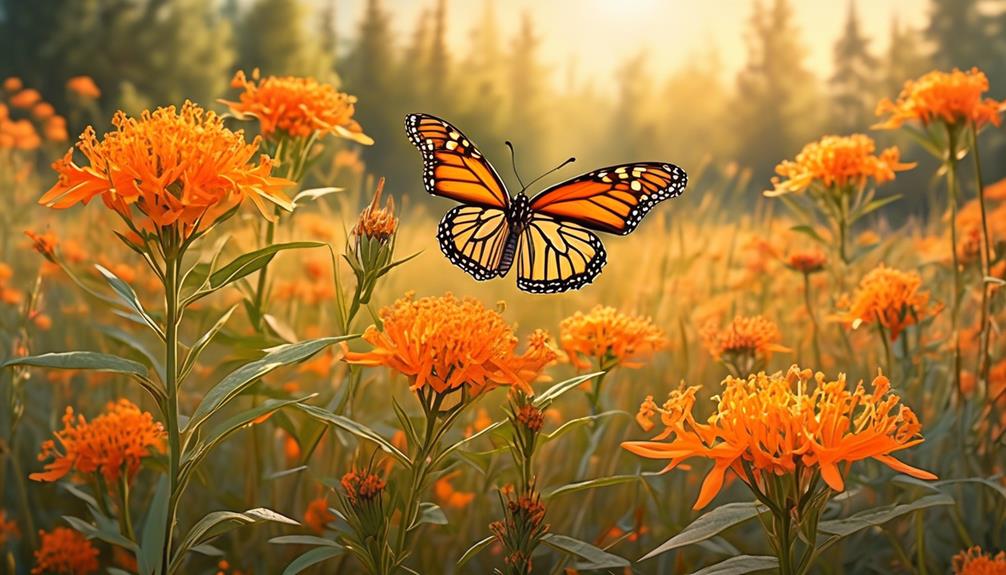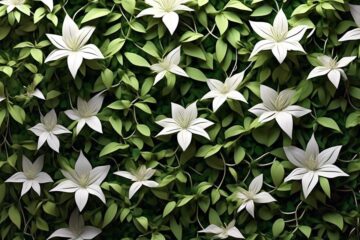Imagine a vibrant meadow, painted with the hues of a summer sunset. As you walk through the swaying grasses, a gentle breeze carries with it the delicate flutter of wings. It is here, amidst this picturesque scene, that Butterfly Weed emerges, nature's magnet for fluttering wings.
But what makes this wildflower so captivating? Why do insects and butterflies flock to its vibrant blooms?
In this discussion, we will explore the alluring qualities of Butterfly Weed and uncover the secrets behind its irresistible charm.
Plant Characteristics
Butterfly weed, a native wildflower found in open places like prairies and fields, boasts unique plant characteristics that make it a magnet for fluttering wings. This vibrant and colorful plant, also known as butterfly milkweed, is an attractive addition to any butterfly garden. Its bright orange and black flowers bloom throughout the summer, providing a feast for butterflies like the Monarch and the tiger swallowtail.
Not only does butterfly weed add vibrant color to your garden, but it also serves as a host plant for these winged wonders. The plant's gaseous composition attracts beneficial insects and provides a valuable food source. With its flexible vinyl shape and head-turningly unusual design, a butterfly weed magnet could be the unique gift or conversation-starter you've been looking for.
Whether you're a butterfly lover or simply appreciate nature's beauty, butterfly weed will surely bring joy to your garden.
Story and Origins
Amidst the prairies and fields, a vibrant wildflower known as butterfly weed emerges, captivating with its unique story and origins.
This native wildflower, belonging to the Milkweed Family, isn't only a sight to behold but also a little magnet for fluttering wings. Its bright orange flowers, resembling little yellow butterflies, make it particularly attractive to butterflies, including the iconic monarch butterfly.
But butterfly weed's allure doesn't end there. Its beauty has inspired artists to create original designs, which they then sell as original locker decor and unique gifts for anybody.
Whether it's through nature photography or adorning your surroundings with milkweed flowers, butterfly weed has a magical story and origins that continue to enchant all who encounter it.
Cultural Significance
With its historical uses and connection to the Monarch butterfly, butterfly weed holds cultural significance that extends beyond its vibrant beauty. Native Americans and early European settlers valued butterfly weed for its medicinal properties, using it to treat conditions such as pleurisy and lung inflammation. The plant's Native American heritage is rich, with it being used as a poultice for bruises and rheumatism, as well as an expectorant, laxative, and diuretic. But butterfly weed's significance doesn't end there. It is also a crucial host plant for Monarch butterfly larvae, providing them with a source of nutrition and protection from predators. This connection to the Monarch butterfly further highlights the cultural importance of butterfly weed. By conserving this plant and its habitat, we not only preserve its vibrant beauty, but also protect the delicate balance of nature's magnet for fluttering wings.
| Butterfly Weed's Cultural Significance | ||
|---|---|---|
| Historical Uses | Native American Heritage | Connection to Monarch Butterfly |
| – Used for treating pleurisy and lung inflammation | – Used as a poultice for bruises and rheumatism | – Host plant for Monarch butterfly larvae |
| – Early European settlers used it for medicinal purposes | – Used as an expectorant, laxative, and diuretic | – Contains glycosides that protect caterpillars |
| – Nicknamed 'Pleurisy-root' for its use in treating pulmonary disorders | – Reflects Native American traditions and knowledge | – Symbolizes the delicate balance of nature |
Butterfly Weed: Pollinator's Paradise
Surrounded by a vibrant array of wildflowers, Butterfly Weed beckons pollinators with its nectar-rich blooms. This native wildflower, also known as a pollinator's paradise, acts as a magnet for butterflies and other winged beauty. Its vibrant color and sweet nectar make it irresistible to these fluttering wings.
Not only does Butterfly Weed provide a feast for these insects, but it also serves as a host plant for Monarch butterflies and other species. This makes it an essential part of their life cycle. By planting Butterfly Weed, you aren't only supporting the beauty of nature but also contributing to the conservation of these delicate creatures.
Butterfly Weed Maintenance Tips
Now that you understand the importance of Butterfly Weed as a pollinator's paradise, let's explore some essential maintenance tips to ensure its healthy growth and continuous blooming.
Butterfly weed, also known as nature's magnet for fluttering wings, requires well-drained soil and full sun to thrive.
When transplanting, be careful not to disturb the plant's taproot, as it can cause damage.
To encourage continuous blooming throughout the season, deadhead spent flowers regularly. This will also help maintain the plant's neat appearance.
Mulching around the plants is crucial to retain moisture and suppress weed growth.
Keep an eye out for pests and diseases, such as aphids, and promptly take appropriate measures to control them.
With these simple maintenance tips, your butterfly weed will flourish and attract an abundance of fluttering wings.
Gift-Giving Occasions
When it comes to gift-giving occasions, there are numerous opportunities to show your appreciation and make someone feel special. Whether it's a birthday, wedding, anniversary, holiday, or housewarming, the right gift can bring joy to any celebration.
Consider personalized gifts, like a print of butterfly weed, nature's magnet for fluttering wings. Supporting independent artists ensures that the artist gets paid real and allows you to find unique prints that you won't find anywhere else. These prints are printed in vibrant color and can liven up a blank space in someone's home.
Concluding Thought
In conclusion, embracing the beauty and importance of Butterfly Weed can truly make a difference in supporting pollinators and preserving our natural world.
This native wildflower, also known as Asclepias tuberosa, acts as nature's magnet for fluttering wings. Its vibrant flowers and sweet nectar serve as a vital food source for butterflies and other pollinators. By planting Butterfly Weed, you're providing a valuable habitat and helping to ensure the survival of these important insects.
Additionally, this plant has historical significance, with Native Americans and early European settlers using it for medicinal purposes. To protect Butterfly Weed and its delicate ecosystem, efforts should be made to conserve its natural habitat and incorporate it into gardens and landscapes.
Frequently Asked Questions
Why Is Milkweed Illegal in the Us?
Milkweed isn't illegal in the US, but some species are considered noxious weeds in certain states. This is to prevent them from disrupting the environment and outcompeting native plants. It's about protecting the ecosystem.
Is Butterfly Weed Bad for Butterflies?
No, butterfly weed is not bad for butterflies. In fact, it's a magnet for them! With its nectar and being a host plant for species like Monarch butterflies, butterfly weed is a vital resource for our fluttering friends.
Where Is the Best Place to Plant Butterfly Weed?
The best place to plant butterfly weed is in open areas like prairies, fields, and roadsides. Make sure the soil is well-drained and the location gets plenty of sunlight. Plant it directly to avoid disturbing the taproot.
What Is the Difference Between Butterfly Weed and Butterfly Milkweed?
Butterfly weed and butterfly milkweed are the same plant, Asclepias tuberosa. They have different flower colors, ranging from deep red-orange to rich yellow. Both attract butterflies and other pollinators with their vibrant flowers.





